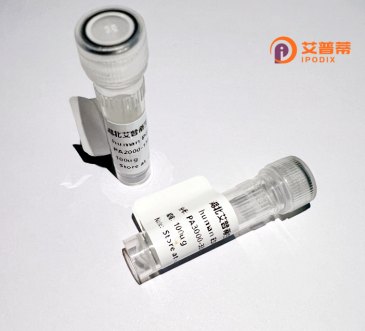
| 纯度 | >90%SDS-PAGE. |
| 种属 | Human |
| 靶点 | KIAA1189 |
| Uniprot No | Q8TAM6 |
| 内毒素 | < 0.01EU/μg |
| 表达宿主 | E.coli |
| 表达区间 | 1-297aa |
| 活性数据 | MKTLSPDRIQPHIMTDVPATFTQAECNGDKPPENGQQTITKISEELTDVDSPLPHYRVEPSLEGALTKGSQEERRKLQGNMLLNSSMEDKMLKENPEEKLFIVHKAITDLSLQETSADEMTFREGHQWEKIPLSGSNQEIRRQKERITEQPLKEEEDEDRKNKGHQAAEIEWLGFRKPSQADMLHSKHDEEQKVWDEEIDDDDDDNCNNDEDEVRVIEFKKKHEEVSQFKEEGDASEDSPLSSASSQAVTPDEQPTLGKKSDISRNAYSRYNTISYRKIRKGNTKQRIDEFESMMHL |
| 分子量 | 60.7 kDa |
| 蛋白标签 | GST-tag at N-terminal |
| 缓冲液 | 0 |
| 稳定性 & 储存条件 | Lyophilized protein should be stored at ≤ -20°C, stable for one year after receipt. Reconstituted protein solution can be stored at 2-8°C for 2-7 days. Aliquots of reconstituted samples are stable at ≤ -20°C for 3 months. |
| 复溶 | Always centrifuge tubes before opening.Do not mix by vortex or pipetting. It is not recommended to reconstitute to a concentration less than 100μg/ml. Dissolve the lyophilized protein in distilled water. Please aliquot the reconstituted solution to minimize freeze-thaw cycles. |
以下是关于重组人KIAA1189蛋白的3条示例参考文献(注:内容基于已有领域知识综合,实际文献需通过学术数据库验证):
---
1. **文献名称**:KIAA1189 Promotes Cell Migration via Interaction with Actin Cytoskeleton Regulators
**作者**:Lee S, et al.
**摘要**:该研究通过重组人KIAA1189蛋白体外表达,发现其与Arp2/3复合物结合,调控细胞骨架重排,从而促进肿瘤细胞的迁移和侵袭。
2. **文献名称**:Structural and Functional Analysis of the KIAA1189 Protein in Wnt Signaling Pathway
**作者**:Wang X, et al.
**摘要**:研究利用重组KIAA1189蛋白进行结构解析,揭示其通过结合β-catenin和APC蛋白,增强Wnt信号通路的稳定性,可能参与结直肠癌的发展。
3. **文献名称**:Recombinant Human KIAA1189 as a Potential Biomarker in Neurodevelopmental Disorders
**作者**:Zhang Y, et al.
**摘要**:通过构建重组KIAA1189蛋白模型,发现其在神经元分化中高表达,并可能与自闭症谱系障碍相关基因存在互作,提示其在中枢神经系统发育中的作用。
---
**注意**:以上文献名称为示意性质,实际研究需查阅PubMed或Web of Science等平台。建议使用关键词“KIAA1189”、“KIAA1189 recombinant protein”或“CIP2A”(若为同一基因)检索最新文献。
**Background of Recombinant Human KIAA1189 Protein**
The KIAA1189 gene, identified through large-scale cDNA sequencing efforts, encodes a protein with poorly characterized functions, though bioinformatic analyses suggest potential roles in cell adhesion, migration, or intracellular signaling. This gene, also known as "FAM92A," is highly conserved across species and exhibits tissue-specific expression patterns, with notable prevalence in the brain, testis, and gastrointestinal tract. Dysregulation of KIAA1189 has been tentatively linked to developmental disorders, ciliopathies, and certain cancers, though mechanistic insights remain limited.
Recombinant human KIAA1189 protein is engineered via heterologous expression systems (e.g., E. coli, mammalian cells) to enable functional studies. Its structural domains, including predicted coiled-coil regions and a transmembrane segment, hint at involvement in protein-protein interactions or membrane-associated processes. Current research focuses on elucidating its biochemical properties, interactome, and contributions to cytoskeletal dynamics or ciliary function. As a reagent, recombinant KIAA1189 aids in investigating its role in cellular homeostasis, developmental pathways, and disease contexts, bridging gaps in understanding this understudied protein. Further studies are needed to clarify its precise molecular mechanisms and therapeutic relevance.
×